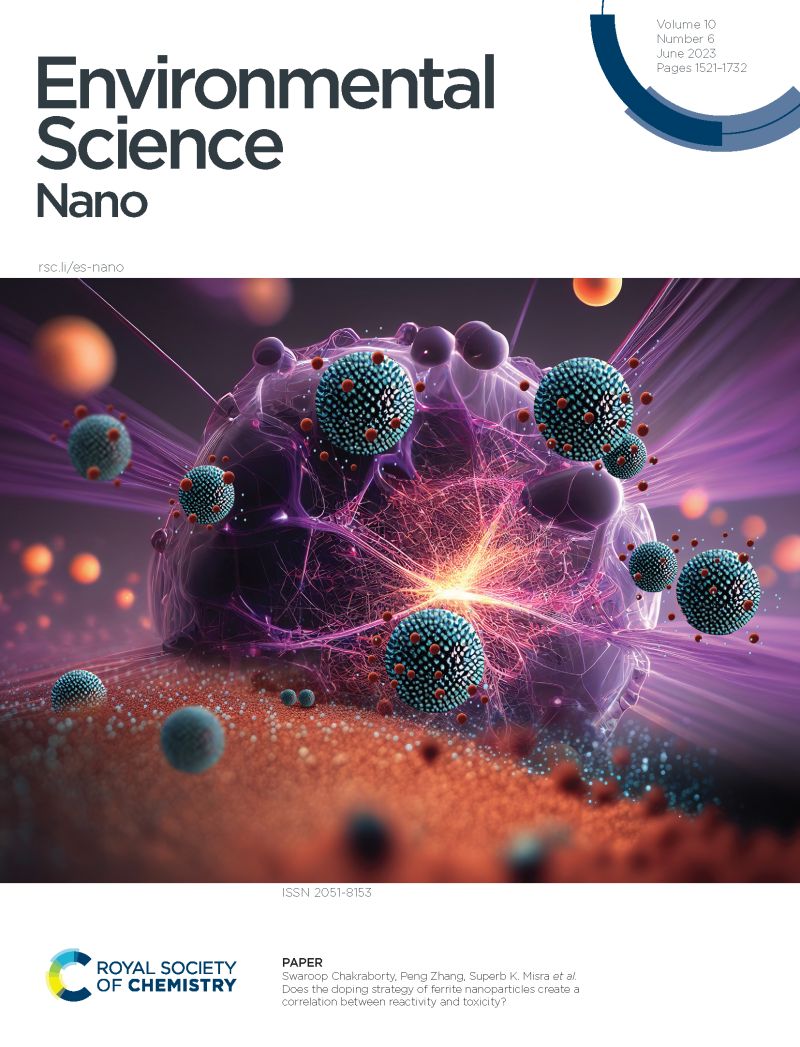一种新型工程纳米除草剂:改善除草剂苯达松的性能、效率和可持续性
IF 5.8
2区 环境科学与生态学
Q1 CHEMISTRY, MULTIDISCIPLINARY
引用次数: 0
摘要
本研究利用一种广泛使用的羽化后除草剂苯达松(Btz)开发了一种新型纳米除草剂,在不影响其药效的情况下,大大减少了所需的剂量。生物相容性和可生物降解的纳米颗粒(即无定形磷酸钙,ACP)已被设计为持续递送除草剂的载体。通过PXRD, FTIR, TEM和元素分析等互补技术对所得纳米复合材料(Btz-ACP)进行了表征,证实了Btz成功加载到ACP纳米颗粒上,并随后在水介质中ph响应释放除草剂。在pH为7和pH为4.5时,释放动力学常数分别为0.11 h−1和0.2 h−1。我们还发现,与游离除草剂相比,Btz-ACP在惰性土壤中的滞留量增加,表明其具有减轻地下水污染的潜力。与商业产品推荐用量(1 kg ha - 1)相比,这种新型纳米除草剂可将除草剂用量显著减少60%,从而有效地控制白芥(Sinapis alba)的生长。值得注意的是,最稀释的Btz-ACP配方(0.4 kg ha - 1)在处理后10天显示出最高的杂草控制(死亡率为96.3±8.8%),优于所有其他测试处理:商业配方(推荐剂量下死亡率为77.4±24.5%,0.7 kg ha - 1降低剂量为74.5±20.1%),以及更高剂量的Btz-ACP (0.6 kg ha - 1)(死亡率为78.1±18.9%),浓度效率呈反比关系。这可能是由于在低剂量下纳米颗粒聚集减少,从而有利于纳米颗粒穿透叶片。有趣的是,尽管剂量大大减少,但在处理后28天后,除草效果仍然明显,避免了目标植物的再生。结果表明,这种新的纳米材料为减少环境影响的可持续农业提供了一种非常有前途的方法。本文章由计算机程序翻译,如有差异,请以英文原文为准。

A novel engineered nanoherbicide: improving performance, efficiency and sustainability of herbicide bentazon
A new nanoherbicide using bentazon (Btz), a widely used post-emergence herbicide, was developed in the present work, to considerably reduce the required dosages without compromising its efficacy. Biocompatible and biodegradable nanoparticles (i.e. amorphous calcium phosphate, ACP) have been engineered to act as a carrier for the sustained delivery of the herbicide. The resulting nanocomposite (Btz-ACP) was characterized through complementary techniques, such as PXRD, FTIR, TEM, and elemental analysis, confirming the successful loading of Btz onto ACP nanoparticles and the subsequent pH-responsive release of the herbicide in aqueous media. Release kinetic constants of 0.11 h−1 and 0.2 h−1 were found at pH 7 and pH 4.5, respectively. We also found that the retention of Btz-ACP was increased in inert soils in comparison to the free herbicide, indicating its potential to mitigate groundwater contamination. This new nanoherbicide allows a significant reduction of herbicide dosage by up to 60% compared to the commercial product at the recommended dosage (1 kg ha−1) to efficiently control the growth of Sinapis alba (white mustard). Notably, the most diluted Btz-ACP formulation (0.4 kg ha−1) exhibited the highest weed control at 10 days post treatment (96.3 ± 8.8% mortality), outperforming all other tested treatments: commercial formulations (77.4 ± 24.5% of mortality at the recommended dose and 74.5 ± 20.1% at the reduced dose of 0.7 kg ha−1) but also higher doses of Btz-ACP (0.6 kg ha−1) (78.1 ± 18.9% of mortality) with an inverse concentration–efficiency relationship. This may be due to the reduction of nanoparticle aggregation at low dosages, thus favoring nanoparticle penetration through the leaves. Interestingly, despite the huge reduction of dosage, the herbicidal effect is still visible after 28 days post-treatment, avoiding the regrowth of the target plant. The results demonstrate that this new nanomaterial offers a very promising approach to sustainable agriculture with reduced environmental impact.
求助全文
通过发布文献求助,成功后即可免费获取论文全文。
去求助
来源期刊

Environmental Science: Nano
CHEMISTRY, MULTIDISCIPLINARY-ENVIRONMENTAL SCIENCES
CiteScore
12.20
自引率
5.50%
发文量
290
审稿时长
2.1 months
期刊介绍:
Environmental Science: Nano serves as a comprehensive and high-impact peer-reviewed source of information on the design and demonstration of engineered nanomaterials for environment-based applications. It also covers the interactions between engineered, natural, and incidental nanomaterials with biological and environmental systems. This scope includes, but is not limited to, the following topic areas:
Novel nanomaterial-based applications for water, air, soil, food, and energy sustainability
Nanomaterial interactions with biological systems and nanotoxicology
Environmental fate, reactivity, and transformations of nanoscale materials
Nanoscale processes in the environment
Sustainable nanotechnology including rational nanomaterial design, life cycle assessment, risk/benefit analysis
 求助内容:
求助内容: 应助结果提醒方式:
应助结果提醒方式:


